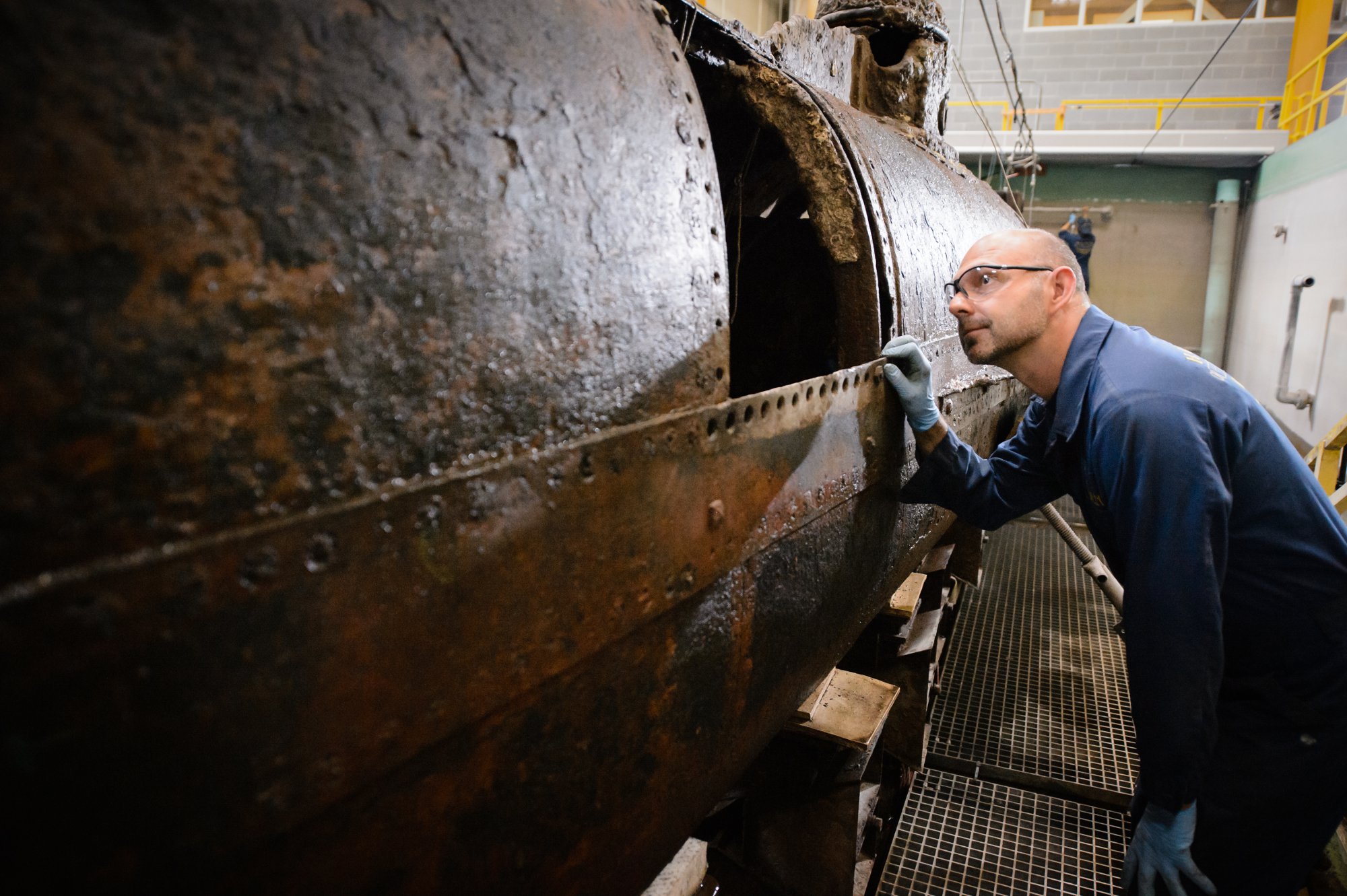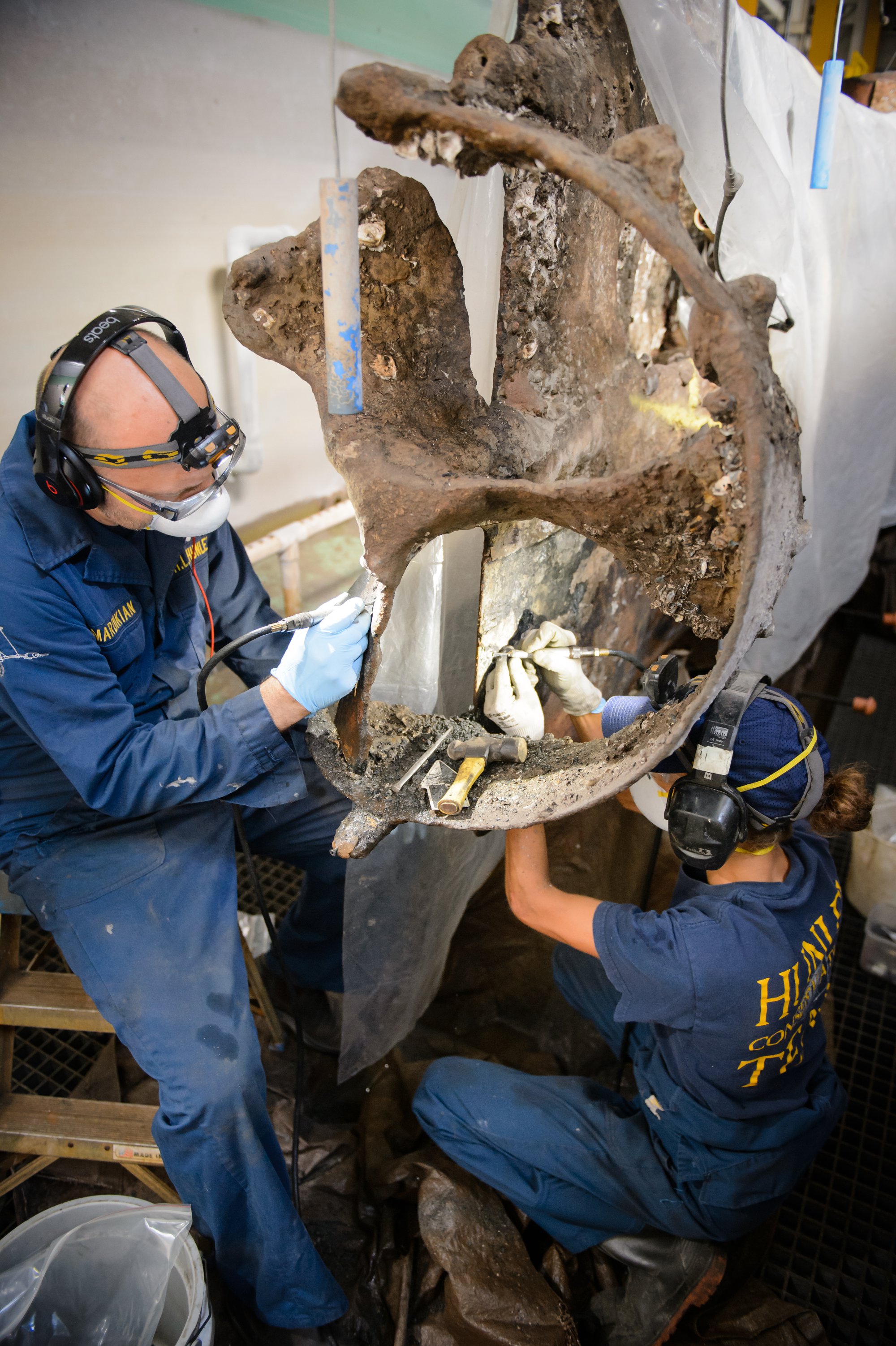a fresh look at the H.L. Hunley
story by Frank Stephenson
photos by Craig Mahaffey
An angry swarm of hornets has invaded the home of the H.L. Hunley.
Or so it would seem from the noise boiling out of the tank where the world’s most famous submarine has rested now for fifteen years.
Finally freed from near-constant immersion in a pool of fresh water—its protective bath since being raised from Charleston Harbor in August 2000—for the first time in 151 years the old sub is showing itself in all of its raw, ironclad beauty.
Shorn of its thick, hardened coat of sand, sediment, and shell, the naked submarine is offering researchers their best clues yet about how the manpowered sub worked and why it famously disappeared after sinking a Union warship blockading Charleston in 1864.
The raucous sound of mad hornets comes from a team of conservators wielding small, but noisy, pneumatic chisels. They chip away the last patches of sea-made crust—residue collected from 136 years of resting on the bottom of Charleston Harbor—from the sub’s hull. This summer, the team celebrated the end of the tedious job of removing all of the material, called concretion, from the Hunley’s iron hide. The work, which took a solid year to complete, was long awaited not only by the Hunley’s caretakers but by maritime archaeologists the world over.
“We are now seeing the actual surface of the submarine. It’s the first time anyone has seen this in more than a hundred and fifty years,” says Stéphanie Cretté, director of Charleston’s Warren Lasch Conservation Center. Home to the Hunley, the center is a cornerstone of the Clemson University Restoration Institute. Since its founding in 2004, the institute has parlayed its oversight of the Hunley project into a busy hub of innovative research on the banks of the Cooper River in North Charleston (see Defining the wind).
“By this time next year, we hope to be done with the next phase, which is (cleaning) the interior,” Cretté says as she helps visitors don rubber boots, safety glasses, and latex gloves for their descent into the Hunley’s damp home. The group has arrived on one of the three days each week that the Hunley’s 72,000-gallon pool of dilute sodium hydroxide is drained to allow conservators to do their work. The caustic bath draws salt from the Hunley’s iron pores, a slow but effective remedy from the effects ofsoaking in seawater for well over a century.
The twelve-member team Cretté now leads (the center’s first director, Michael Drews, retired in 2012) has evolved over the years but remains focused on finishing one of the most challenging restoration projects in American maritime history. As detailed in Learning from the Hunley, the story of the Hunley’s 1995 discovery and subsequent resurrection has focused international attention on Clemson’s efforts.
Stages of recovery
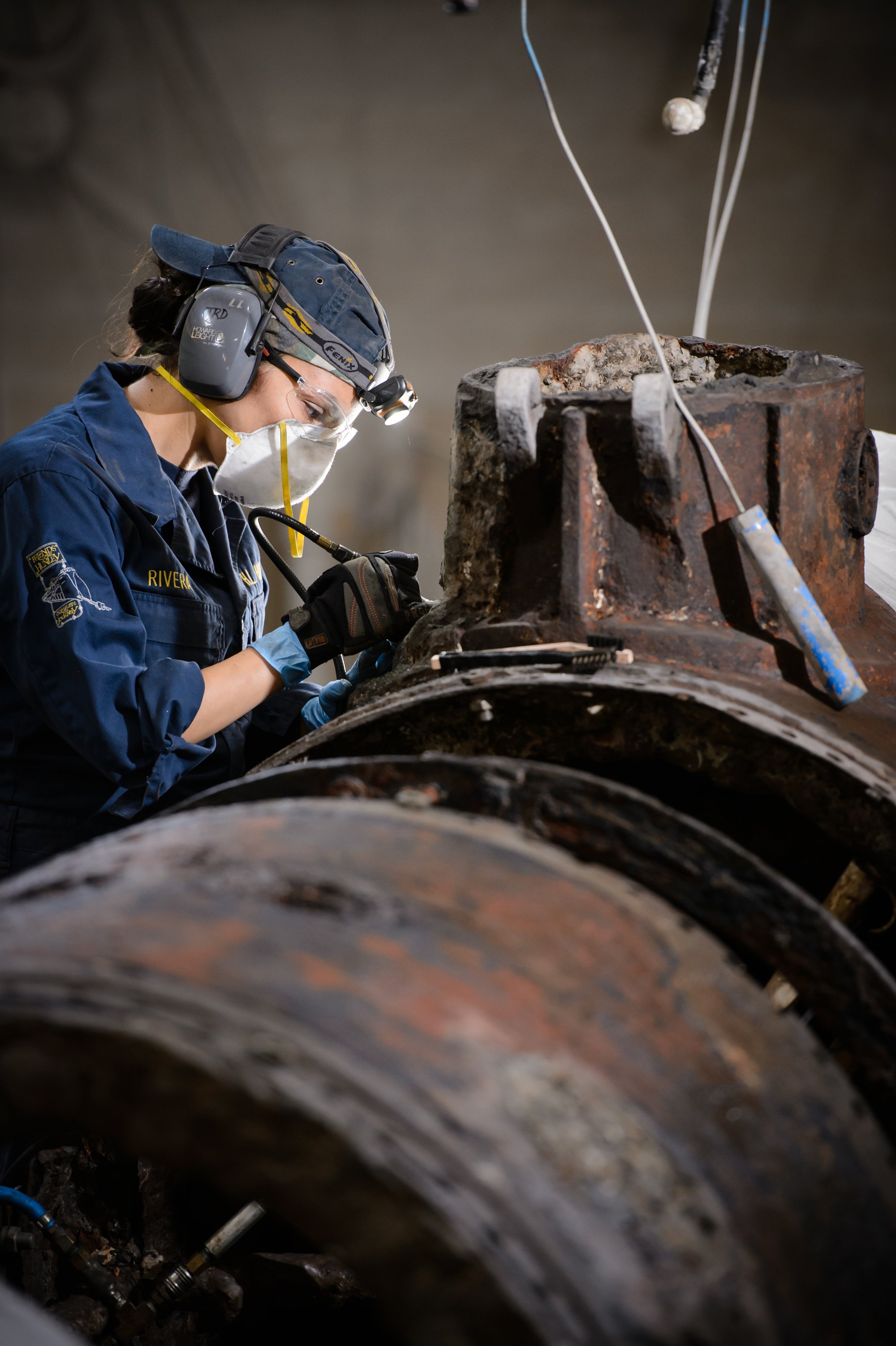
Even before the de-concretion process began in 2014, the team of conservators hoped the work would reveal tantalizing clues about the Hunley’s final moments, solving one of the Civil War’s most puzzling mysteries.
So far, the exhaustive restoration work has been punctuated by four pivotal events. Obviously the first, which drew world attention, was the recovery of the submarine itself from its muddy grave, moving it ashore and setting it up in a highly specialized holding tank. Four years later came the excavation of the sub’s interior, filled to capacity with thick, gooey sediment. That excruciatingly painstaking work culminated with the recovery and analysis of the remains of the sub’s eight-man crew, including the Hunley’s twenty-seven year-old skipper, Lieutenant George E. Dixon.
After years of study and intense debate, in 2011 the sub successfully underwent a risky procedure in which it was rotated to its original vertical position. Discovered resting on the seafloor at a 45-degree angle, the sub was recovered exactly as it was found. Archaeologists feared that righting it might destroy priceless archaeological clues that remained inside. Even after the recovery of the crew’s remains and dozens of artifacts, the team knew that rotating the vessel still posed the threat of irreversible structural damage.
To everyone’s relief, the project went smoothly and the sub was finally freed from a thicket of heavy slings that had held it in place for eleven years. Without this critical maneuver, team archaeologists say that the latest phase—removing the sub’s heavy coat of concretion—would have been all but impossible.
Paul Mardikian has been front and center for every phase of the Hunley’s restoration. Trained in conservation sciences at the Sorbonne, France, Mardikian signed on as the Lasch team’s senior conservator in 1999, a full year before the Hunley was raised. He’s worked on other Civil War projects as well, notably restoring cannon recovered from the CSS Alabama, which, like the Hunley, also sank in 1864, albeit off Cherbourg, France.
As he chiseled away the last deposits on the Hunley’s propeller last June, Mardikian reflected on why the meticulous de-concretion work was necessary and what it had revealed so far.
“We are now able to essentially read the hull,” he said. “Before, with all the concretion there, we basically had only x-rays of the sub to look at and study. Now, we can look directly at the surface, and there’s just no substitute for that. Now the challenge is to read and properly interpret what we can see with our own eyes.”
Before the sub’s hull was stripped of its crusty shell—which was found to be over an inch thick in places—every bump, curve, indention, ripple, or other surface anomaly was masked so heavily that the vessel resembled a piece of natural rock snatched from the seabed. Contrasting before-and-after photos show a stunning transition from what once could have passed for an entirely organic object to a sleek slab of incredibly specialized Civil War iron.
Mardikian traced a gloved hand over a cleaned propeller blade. Beside it was its crusty mate, still bearing the likeness of a shard of curved concrete.
“This is just like looking at someone’s body, looking at the scars. We see scars but we don’t always know the chronology, the full story of how they got there. After all, we’re dealing with a submarine that sank not just once but three times.”
The Hunley at ground zero
Assuredly, well before the de-concretion process began in early 2014, the team was optimistic that the work would reveal tantalizing clues about the Hunley’s final moments. In the forefront of everyone’s mind was what could be called the eureka discovery, incontrovertible evidence that would finally solve one of the Civil War’s most puzzling mysteries.
Clearly, on that cold February night of 1864 some four miles off Sullivan’s Island in Charleston Harbor, something went terribly amiss. What happened? Alas, the latest work sheds scant new light on a question that has vexed historians, naval experts, scientists, and Civil War buffs for over a century-and-a-half now. A definitive answer may never be found, but the Hunley team is justifiably proud of having now assembled the most complete set of clues ever compiled. They are anxious to explore the only place where the final clues can be hiding, and that’s beneath the still heavily encrusted walls and machinery of the sub’s interior.
Interestingly, two of the best clues were found just before the latest cleaning process began. In 2013 the team finally finished cleaning and restoring the tip of the 17-foot iron spar that had been soaking in solution since the sub was raised. The spar served as the Hunley’s only weapons delivery system, essentially a lance tipped with a torpedo loaded with 135 pounds of gunpowder. It was found detached from the sub and lying only a few feet away from the hull in 1995.
What researchers found upended a Hunley narrative that had reigned since almost the night the sub vanished. The torpedo was revealed to have been bolted to the spar with a copper casing, and therefore apparently was never designed to be detached and detonated from a distance, a central tenet of Hunley lore. With the concretion gone, it was obvious that some mighty force caused the casing’s sheath to peel back onto the spar like a ripe banana skin, ripping a gash in the casing where it was thrubolted. The discovery proved beyond any doubt that the Hunley was only seventeen feet away from the torpedo when it went off. Until then, researchers could only speculate about the sub’s proximity to its lethal attack.
The blast-deformed torpedo casing means that the Hunley and its crew felt the full force of a horrendous underwater explosion from a distance of just short of half the length of the sub itself. The proximity of the explosion could almost be likened to the Hunley having struck a mine.
In Harm’s Way
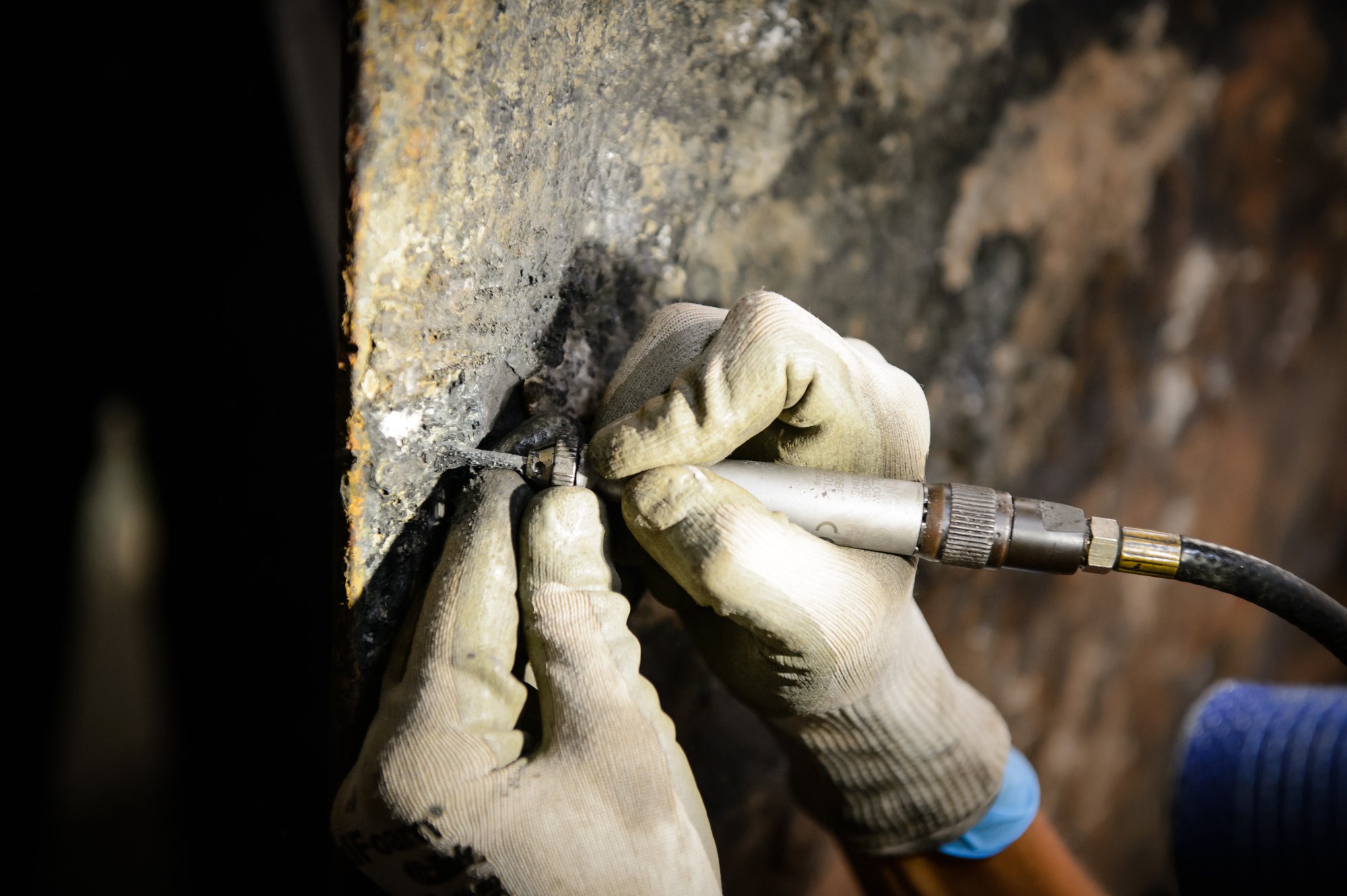
A thick, hardened coat of sand, sediment, and shell, the concretion on the sub is being carefully chiseled away.
Even so, with the sub now completely out of its shell, the most obvious finding reinforces what conservators had surmised early on: namely, that the Hunley was an amazingly tough piece of war-making machinery. Mardikian and his teammates found no evidence that the explosion inflicted any damage at all on the Hunley’s primary defense—its sturdy, wrought iron hull. None of the sub’s 3/8″-thick hull plates showed any sign of shrapnel damage, much less cracking or buckling, injuries that surely would have sent the sub to the bottom in a hurry. The absence of such damage helps explain why the sub was able to survive sinking for a considerable length of time. The sub eventually sank more than three football fields away from where its victim, the Housatonic, dropped to the mud within five minutes of the attack.
A computer-simulated test conducted in 2013 by the U.S. Navy’s Surface Warfare Center in Washington, D.C., suggested a reason why the sub was able to survive the blast at what amounted to point-blank range. The navy researchers concluded that the charge carried by the Hunley would likely have generated only 350 pounds per square inch of pressure—a force determined to be insufficient to breach the sub’s walls.
But significantly, the navy conceded that the blast could have severely, even fatally, injured the sub’s crew. Forensic analysis of the crew’s skeletal remains in 2004 showed no evidence of bone fractures. But medical literature is full of accounts of the lethal effects of underwater explosions, which can be far deadlier than surface or airborne blasts yet cause no broken bones or lacerations. The Hunley’s eight crewmen were hit with a vicious underwater concussion unlike anything they or any of their Confederate comrades had ever experienced in either training or combat. (At this writing, the navy still has plans for another experiment, this time using real gunpowder—made with the same formula used by the Confederacy—in a test at sea.)
Finding that the Hunley’s hull withstood the brunt of the explosion, while fascinating, hardly means that the blast didn’t seriously damage the vessel in other ways, said Mardikian. Finally able to study the outer skin in great detail, Mardikian is now convinced more than ever that a discovery he made several years ago is solid evidence connecting the explosion to the Hunley’s fate.
While trying to understand how the Hunley’s ballast system worked, Mardikian noticed that the bronze intake pipe attached to the sub’s forward seacock—a valve for letting in water—was oddly misaligned. Closer inspection revealed that the seacock’s pipe—almost the diameter of one’s wrist—was snapped in two right where it went through the hull. Because bronze is essentially impervious to seawater corrosion, Mardikian knew that corrosion couldn’t possibly have caused the damage he’d found.
In their test, the navy researchers took into account the broken seacock pipe and deduced that if it had been caused by the explosion, the damage could have allowed a lot of water to pour into the Hunley’s crew compartment very quickly. Even if the pipe initially suffered only a hairline fracture, researchers speculate that the leak still could have threatened to sink the sub if the crew didn’t take immediate action to staunch the flow. In the excavation of the interior, completed in 2004, no evidence was found to suggest that the crew made any effort to address any leakage problem.
Mardikian is convinced that the broken pipe was “a catastrophic failure” that played a major role in the Hunley’sdemise. He likens the damage to what’s depicted in every movie depicting submarine warfare. When nearby depth charges go off, submarines that star in films unfailingly start spewing water and steam. It’s not Hollywood fiction—survivors of submarine combat during WWII lived to describe the horrors of watching their ships fill with water from pipe fittings sheared by fierce explosions.
“It’s easy to imagine that something similar happened here,” Mardikian says. “The (shock of the) explosion was enough to cause the sub to flex. The seacock pipe was fixed and very rigid. It’s reasonable to suggest that any flexing would have broken it where it did.”
The valves of life (and death)
Launched in July 1863 from its birthplace at a foundry in Mobile, Alabama, the Hunley led a brief and frightening life.
Rushed by rail to Charleston to help fight off the Union’s fleet of blockade ships, within eight months of leaving Alabama the forty-foot-long, twenty-ton submarine would be on the cold bottom of Charleston Harbor with its third ill-fated crew still aboard. It had already sunk twice before in sea trials, killing five crewmen the first time and all eight the second, including the vessel’s namesake, Horace Lawson Hunley. Each sinking forced desperate Confederate commanders in Charleston to pay salvors handsome sums to raise the vessel, recover the bodies and make whatever repairs or modifications were necessary to throw the Hunley into battle.
Both sinkings, the second in particular, were suspected of being caused by human error. Even with its namesake Hunley at the controls, the sub’s loss was blamed on mistakes made in handling the all-important ballast system. Controlled by forward and aft valves for regulating both the intake and expulsion of seawater, the sub’s fate literally lay in the hands of men who knew how the system worked.
“If you can’t control the valves, it’s life or death,” says Michael Scafuri, an archeologist on the project. “You had to be absolutely certain how the valves were positioned at all times.”
Scafuri and his research assistant Brad Blankemeyer study the Hunley’s ballasting and propulsion systems. They have successfully removed, de-concreted, and restored one of the sub’s two ballast tank pumps, the aft unit. The forward pump remains heavily concreted and sits in its original place, awaiting the final cleaning of the interior. Both pumps were capable of forcing water out of the ballast tanks or the sub itself if necessary, but to work, both required their independent valves to be properly set.
They found that the aft pump apparently was in proper working order when it was last used, and even contained seawater still sealed inside by its single piston, whose cotton gasket was found to be remarkably well preserved. The valve controlling the aft pump was found to be closed, as it should have been, given that both ballast tanks were probably full to allow only the Hunley’s twin conning towers to be visible as it approached its target.
But what about the forward valve? In attempting a dive during a training exercise, Hunley drowned himself and his crew when he apparently failed to close the forward seacock valve when he should have.
Scafuri and his team have discovered that even though the forward valve appears to be in a closed position (its handle is perpendicular to the pipe), there’s something curious in the setup. Space being what it was on the impossibly cramped Hunley, the captain’s seat was squeezed into position directly atop the valve’s handle. This configuration would have made it difficult, if not impossible, to operate the forward valve the same way as the aft valve.
“The captain simply couldn’t fit his seat on there and operate the (valve) handle,” Scafuri says. “So, we have to wonder whether these two valve handles were put on differently.”
As found, the forward valve’s configuration appears to be in the open position. Could the Hunley’s brash young commander, George Dixon, have repeated H.L. Hunley’s mistake on his famous run to destiny?
“We won’t be able to know (whether the valve is on or off) until the interior is fully de-concreted,” Scafuri says. “Was human error involved again? Right now, it’s an open question.”
Final approach
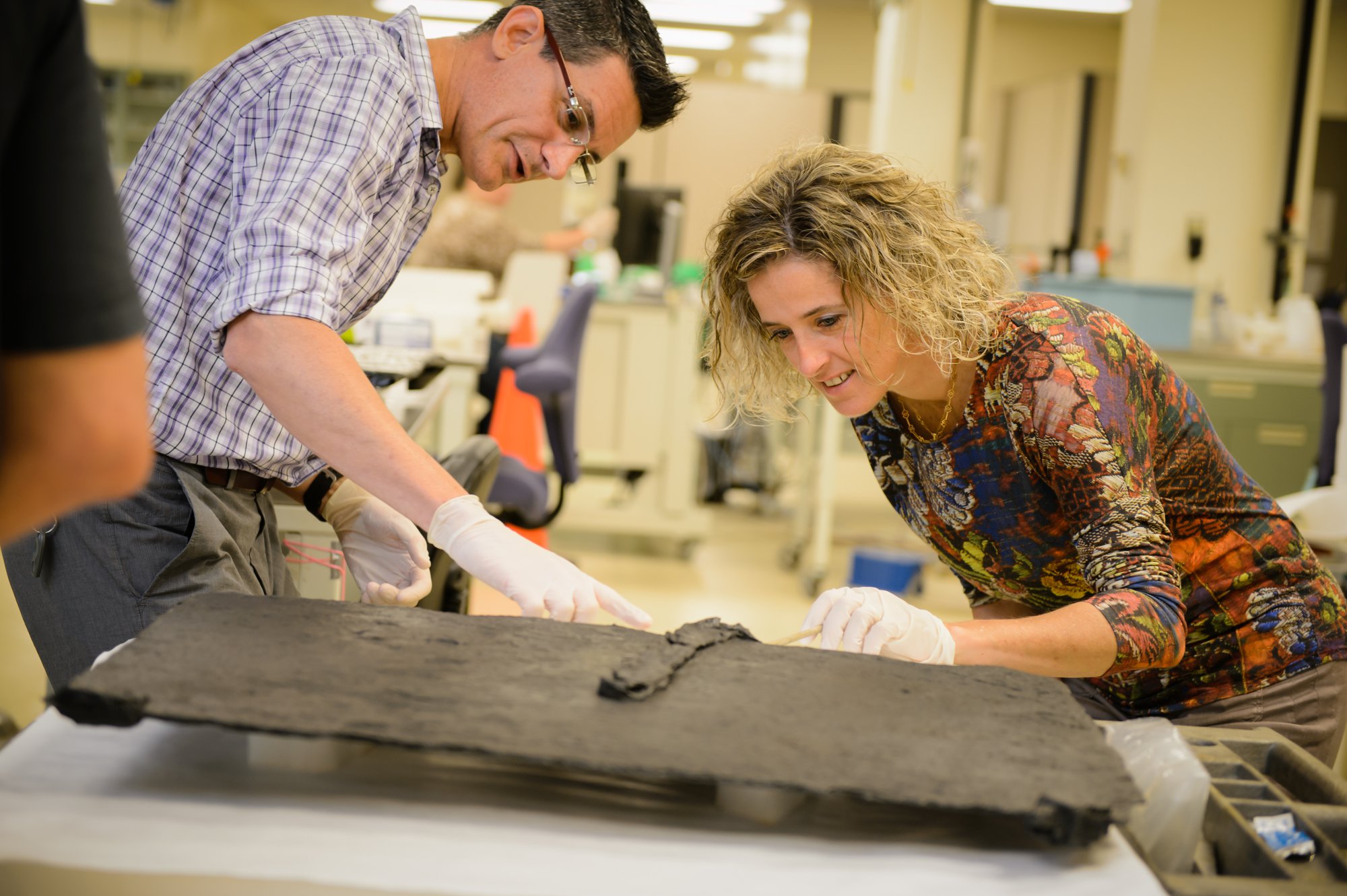
Stéphanie Cretté, director of the Warren Lasch Conservation Center and a research professor of materials science and engineering, is hopeful that the work will be done by next summer.
The Hunley’s restoration team begins the next phase with some trepidation. Taking the shell off the sub’s interior will require a more delicate approach, Cretté says. Not only can the interior be a beastly place to work because of its size (3½ feet in diameter), the old vessel’s bones are fragile.
“We can only put two conservators inside at the same time because of the weight. So, this will likely mean that (deconcreting) the interior probably won’t go as fast as did the exterior.”
Still, Cretté is hopeful that the work will be done by the summer of 2016 or the summer of 2017. After that, the sub’s tank will once again be filled with salt-removing chemicals for a final long soak, this one expected to take roughly five years to complete. Cretté says the current schedule calls for the Hunley to be ready for its final transition to a museum sometime in 2020. A quarter century after its discovery, the H.L. Hunley will finally be fully displayed to an eager world audience. Visitors are likely to see a sleek, almost solid black vessel, its iron skin darkened by special, deep-penetrating corrosion inhibitors. Touching the sub won’t be possible, because it will be permanently housed in an air-free, ultra-low-humidity cocoon of sorts. To keep corrosion in check, the container also may be filled with argon or some other inert gas.
After the Hunley goes on public display, Cretté says, the work of the Lasch team is poised to continue, thanks to some one-of-a-kind spin-off technologies and talents that the project generated during its fifteen-year run. In particular, she says, the lab is building on its expertise in such diverse fields as materials analysis and 3-D imaging. Techniques developed by the lab already have helped conserve and analyze a wide variety of metals and textiles used in fields outside of archaeology.
“We’ve built a wonderful resource here and we’re looking forward to the future.”
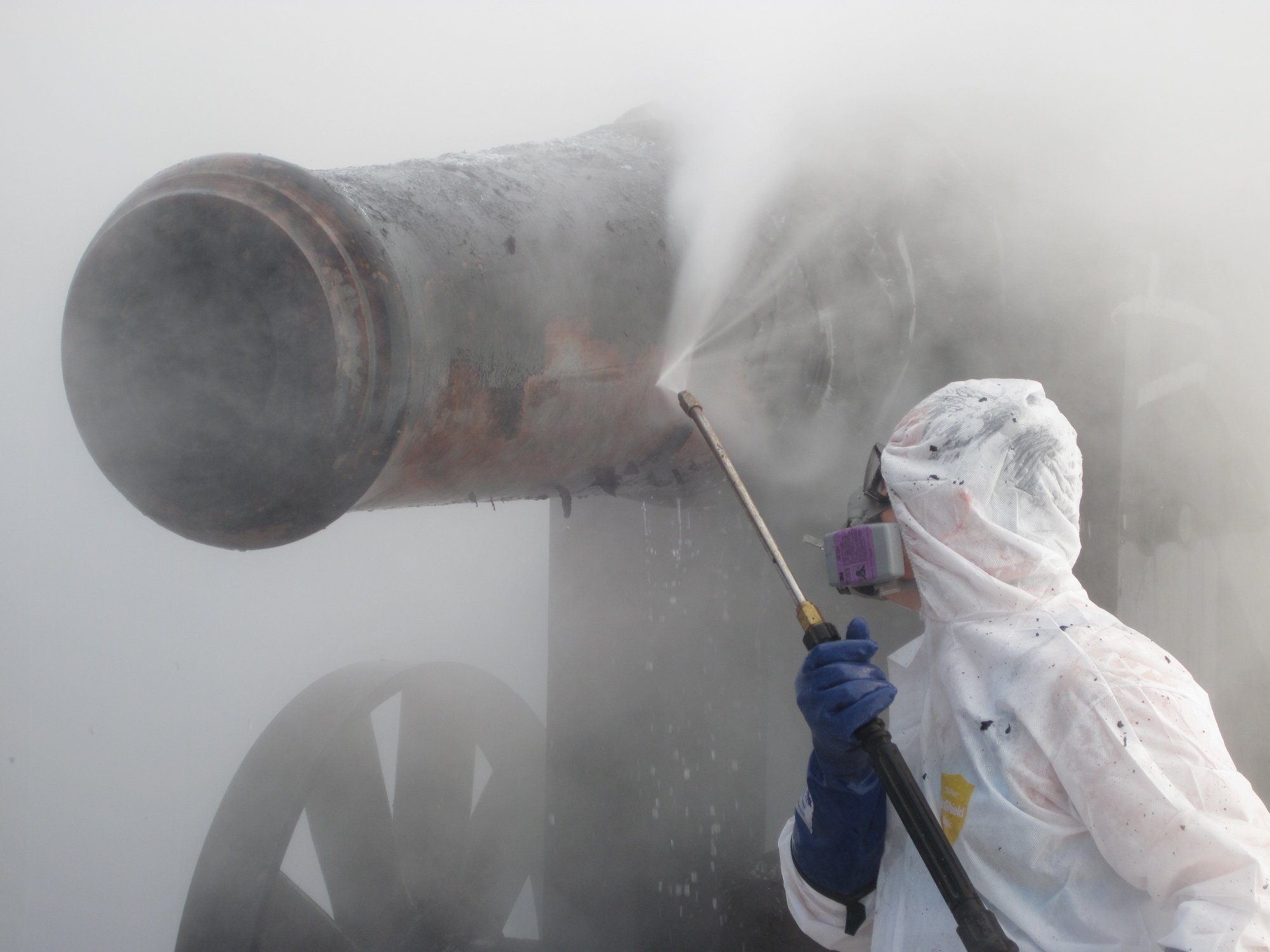
Beyond the Hunley’s past—into conservation’s future
The Warren Lasch Conservation Center is more than the H.L. Hunley.
In previous issues, we’ve covered many of the center’s other conservation projects. Subcritical technologies, which accelerate the desalination of iron exposed to maritime environments, were explored in Glimpse Fall 2012, and now Liisa Näsänen, a doctoral candidate at the University of Cardiff, is researching in collaboration with the Warren Lasch Conservation Center (WLCC) the possibility of applying the subcritical process to the desalination of copper and copper alloy artifacts. In the spring 2013 issue, we covered the conservation of the ordnance and architectural elements of Fort Sumter and Fort Moultrie, where the WLCC is the only U.S. institution to apply ThermaTech technology to metal conservation, using donated equipment from Restorative Techniques-UK that removes coating layers with superheated water so that conservators can reapply commercial coatings that will protect these objects from the elements. Additional work is being done on ordnance, as the WLCC has received three cannons recovered from the Pee Dee River by the South Carolina Institute for Archaeology and Anthropology (SCIAA). The center is also working with the University of Montana and the Naval History and Heritage Command to conserve ordnance from the historic U.S.S. Maine.
But what we haven’t yet explored in these pages is the Low Country Digital Initiative, created to systematically document the cultural and architectural history of South Carolina’s Low Country and beyond. This, and the Warren Lasch Conservation Center’s similar projects in 3-D scanning, offer new opportunities to those interested in historic conservation—so that we can understand the history around us better than ever before.
Stéphanie Cretté, director of the WLCC and a research professor of materials science and engineering, says, “The laboratory champions an integrated approach where conservation practice, archaeology, architecture, and materials science work together to solve preservation challenges; the facility houses a state-of-the-art materials analysis, characterization, and documentation laboratory. Currently the WLCC employs a wide range of digital documentation technologies, including photogrammetry, structured-light scanning, and 3-D laser scanning.
“Laser scanning is becoming extremely accurate, and it can be applied under many circumstances,” continues Cretté. “It’s more important than ever to have good documentation on the 3-D level instead of photos, because if something happened, like a natural disaster or even wanted destruction, you can have a building rebuilt from its 3-D scan. You can recreate the blueprint.”
Here are a few examples of 3-D digital documentation projects that are part of the Low Country Digital Initiative:
• At the Colonial Dorchester State Historic Site, conservators have used 3-D laser scanning to document a delicate window frame on a bell tower, which is now undergoing treatment in the conservation laboratory.
• In St. George, Bermuda, conservators and architectural historians plan to scan and assess King Square and the King Street corridor. Depending on funding, this contract may be extended, and the entire city may be scanned and documented, taking an already ambitious project to an unprecedented level.
• In collaboration with the Charleston Preservation Society, the WLCC has laser scanned the Old Sheldon Church Ruins in Yemassee, South Carolina, adding in raw point cloud data with high-resolution color photographs, resulting in a 3-D model that’s accurate to within two millimeters and that additionally contains mortar data, as different mortars were determined through chemical analysis and then mapped onto the model.
• The WLCC has also performed the scanning and digital documentation of the exquisite Pompion Hill Chapel through a State Historic Preservation Office grant over the summer of 2015. By using the highly accurate and noninvasive laser scan, the researchers produced a model of the chapel that could be used for identifying and monitoring repair issues. The model, integrated into the site management plan, is an important tool for planning future repairs and maintenance.
• The center has several adjunct professors teaching in the Graduate Program of Historic Preservation and this spring is offering a course on the utilization of x-ray fluorescence (XRF).
• Additionally, the Warren Lasch Conservation Center intends to offer a summer field school, taught by Brent Fortenberry, an architectural historian and archaeologist of the WLCC, where undergraduate and graduate students can receive training in methods of digital documentation like structural scanning, photogrammetry, and 3-D laser scanning.
To create a complete picture of a historical object, in addition to using documentation techniques like laser scanning or photogrammetry, the conservators need to get an idea of the material composition. Analytical tools such as x-radiography, Fourier Transform Infrared Spectroscopy, Raman spectroscopy, XRF or Variable Pressure Scanning Electron Microscope Energy Dispersive Spectroscopy can enable them to determine an object’s chemical composition. In some cases where the testing has to be done on-site, conservators use a handheld XRF. Cretté explains that understanding the composition of an object is important because conservation techniques must be compatible with the object’s chemical composition.
“When we analyze materials such as wood, brick, metal, or mortar, we want to understand the best way to conserve or reserve a structure or an artifact,” Cretté says. “We always follow the ethics to conserve a site. We have to give the best recommendation to the stakeholders, and 3-D scanning can help toward best practice to preserve a site.”
But 3-D scanning offers additional benefits, Cretté says. Take the case of the bell tower frame. The delicate frame will not be put back up, but a 3-D model could be displayed to visitors. In the future, museums might use 3-D models to display artifacts to the public that are otherwise too fragile. Perhaps someday, with the help of a digital arts production team, 3-D cultural museums could be developed.
These digital documentation technologies, coupled with the Warren Lasch Conservation Center’s expertise in materials and conservation science, ensure that structures and artifacts around us can be understood more thoroughly than ever before.

